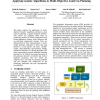Free Online Productivity Tools
i2Speak
i2Symbol
i2OCR
iTex2Img
iWeb2Print
iWeb2Shot
i2Type
iPdf2Split
iPdf2Merge
i2Bopomofo
i2Arabic
i2Style
i2Image
i2PDF
iLatex2Rtf
Sci2ools
GECCO
2000
Springer
2000
Springer
Applying Genetic Algorithms to Multi-Objective Land Use Planning
This paper explores the application of multiobjective Genetic Algorithms (mGAs) to rural land use planning, a spatial allocation problem. Two mGAs are proposed. Both share an underlying structure of: fitness assignment using Pareto-dominance ranking, niche induction and an individual replacement strategy. They are differentiated by their representations: a fixedlength genotype composed of genes that map directly to a land parcel's use and a variablelength, order-dependent representation making allocations indirectly via a greedy algorithm. The latter representation requires additional breeding operators to be defined and post-processing of the genotype structure to identify and remove duplicate genotypes. The two mGAs are compared on a real land use planning problem and the strengths and weaknesses of the underlying framework and each representation are identified.
GECCO 2000 | Land Use Planning | Multiobjective Genetic Algorithms | Optimization | Spatial Allocation Problem |
Related Content
| Added | 24 Aug 2010 |
| Updated | 24 Aug 2010 |
| Type | Conference |
| Year | 2000 |
| Where | GECCO |
| Authors | Keith B. Matthews, Susan Craw, Stewart Elder, Alan R. Sibbald, Iain MacKenzie |
Comments (0)

